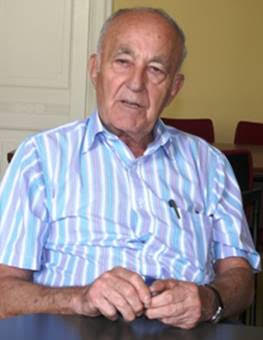
THE VOICE OF INTERNATIONAL LITHUANIA
|
VilNews has its own Google archive! Type a word in the above search box to find any article.
You can also follow us on Facebook. We have two different pages. Click to open and join.
|
Health & wellbeing
- Posted by - (6) Comment
Love and suicide in Lithuania

ARŪNAS SAKALAUSKAS: I INVITED 1095 PEOPLE TO LIE DOWN IN THE CATHEDRAL SQUARE
OF OUR CAPITAL CITY VILNIUS FOR EVERY SUICIDE MADE LAST YEAR.
Photo: Vladimiras Ivanovas
By Dr. Boris Vytautas Bakunas
A young Lithuanian policeman is found slumped in the seat of his car shot dead, his weapon clutched in one hand – in his other hand his mobile phone containing a text message he had received: “I love another” (report by psychologist Andrius Kaluginas).
According to the World Health Organization, Lithuania now has the highest suicide rate in the world. Psychiatrists, sociologists, and journalists often link Lithuania’s skyrocketing suicide rate to social instability, poverty, high unemployment, and alcoholism.
What has gone largely unnoticed is that one of the leading causes of suicide among people under the age of thirty is unrequited love. Read more…
- Bookmark :
- Digg
- del.icio.us
- Stumbleupon
- Redit it
- Posted by - (13) Comment
The beggar woman
of Kaunas
 By Boris Vytautas Bakunas
By Boris Vytautas Bakunas
It was bitterly cold in Kaunas that December of 2003 during my first visit to the land of my ancestors. Driven by gusts of bone-chilling wind, I sought warmth inside a delicatessen just off Laisves Aleja.
The old woman stood so close to the door that I nearly crashed into her. Snow swirled in behind me like a white cape, sending its flakes towards the last-minute Christmas shoppers inside. Several cast glances at me, and seeing nothing unusual, turned away.
I could barely hear the muttering, hushed tones the old woman spoke...She was so small that I had to bend my head to see her. A frayed white headscarf tightly hugged a wrinkled face – a face battered by at least 70 years of hard living.
Her lips were moving in cadence with her head, which bobbed up and down ever so slightly as if she were saying her rosary. But there were no beads in the cupped hands that stretched towards me. It was then that I understood she was begging.
I had seen beggars before. I remember one legless beggar sitting in child’s little red, steel wagon in front of a dime store in Chicago’s Bridgeport neighborhood where my family moved just as soon as my grandfather found work in the steel mills. No matter how poor we were, my mother always found a quarter to give him, and he always greeted her gleefully when he saw her coming his way.
I fumbled through my pockets finding only a few litai. The old woman took them. Then she humbly clasped my hands in hers. Her hands were old and gnarled like the roots of an ancient oak clutching the earth.
“Dekuj, dekuj,” she muttered, her head bowing in gratitude. “For what?" I wondered. “A few litai?”
A wave of anxiety swept through me. You know that sinking feeling which calls up a memory flash so brief that you forget the details, and all you are left with is cold dread.
I feverishly searched my pockets again. Empty.
“Wait here,” I said. “Don’t move. I’ll be right back.
I skidded across the icy street to a bankomat and got – I don’t know how much – maybe sixty dollars worth of litai.
Then I rushed back. Would the old woman still be there when I got back?
I shoved a crumpled ball of paper money into her hands. As she began unwrapping it, I tried to leave. But a hand tore into my sleeve. All I remember were the tears running in rivulets down her wrinkled face and the words “Dekuj, dekuj” and something about how she and her daughter who was ill would have heat this month and could celebrate a real Christmas.
“Ner už ką,” I blubbered. “It’s nothing, nothing really.”
The living room of my cousins’ apartment was decked with a feast you’d expect to find on a luxury liner. Though far from rich, they had spared no expense to greet their relative from abroad. My aged aunt, the youngest sister of my dead father, marveled that I had not forgotten my native tongue. Toast followed toast. Laughter rung out like the sound of Christmas bells and chimes.
I laughed, too. But my thoughts were elsewhere. I had come to Lithuania bearing the ashes of my mother, in fulfillment of her wish to be buried in her beloved Kaunas. And now I thought of my last days with her and the gifts she had given me.
The gift of her labor, the seemingly endless of hours of toil she spent working in factories for a pittance during our first decade in America.
The gift of her words, the words she spoke to me just before I started school, telling me that if I worked hard one day I would work in an office or maybe even be a teacher myself..
And I remember her gift of compassion. No matter what our circumstances, she always managed to have something left over to give to others -- a donation to a charity, a Sunday offering to the Church, and always a quarter to every beggar she saw.
I have seen beggars wherever I’ve been. I have seen lame beggars, beggars without legs, beggars with bent backs. I’ve seen young beggars barely out of their teen-aged years, their arms pitted with scabs and their hands swollen from drugs. I’ve seen healthy, strong beggars. And beggars who smelled a saloon.
I have heard people say, “Don’t give him a cent. He’s healthy. He’s strong. Why doesn’t he find a job and work like the rest of us?”
“He’ll just waste it all on drink.”
And I remember my mother’s words, “How sad it is that the only joy some men can find in life comes in a bottle.”
And now I remember the old woman with the frayed white headscarf in Kaunas during the winter of 2003 muttering “Dekuj, dekuj” and weeping, and I remember thinking of her sick daughter. Did they have their real Christmas in a warm apartment that year? I hope so. Was it their last Christmas? I hope not. Oh God, I hope not.
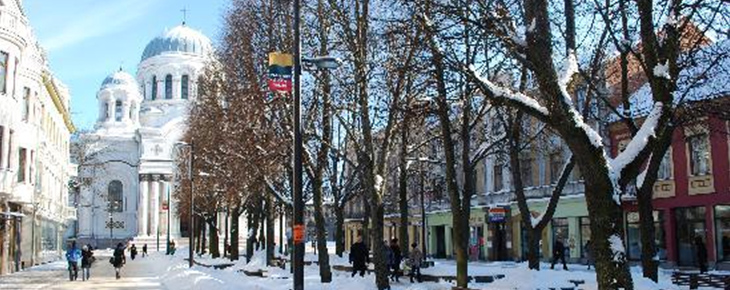
- Bookmark :
- Digg
- del.icio.us
- Stumbleupon
- Redit it
- Posted by - (5) Comment
Healing the heart and
soul of Lithuania

By Ida Hardy, Texas, USA
Lithuania is my mother’s country. She escaped with her mother and sisters as a young child and at one point in her life she wanted to return. It seemed to me that she heard the whispers from the wind in the forests and they were calling her home. My mother taught us a little about the folk tales and the music. She taught us to meditate and a little bit about yoga and I wanted to learn more about her childhood home. But the Soviets were still reigning and it was impossible for us to go. Later, as we cried on the phone on that day in 1991 I asked her if she would like to return and she said, “You can never go back. Things are changed so much.”
Her message was about more than the structure of her home and the murder of her father. She was really talking about the broken spirits of all the people who were victims, those who were aggressors, and those who were both. There is no going back. No one can undo the evil that has taken place anywhere on the planet throughout time.
 I’m a yoga teacher and natural health practitioner. I learned much of what I know from my mother, and everything else I learned at University. University may have offered more details but I think it all simply confirmed everything she taught about keeping the body healthy. Probably what every mother teaches.
I’m a yoga teacher and natural health practitioner. I learned much of what I know from my mother, and everything else I learned at University. University may have offered more details but I think it all simply confirmed everything she taught about keeping the body healthy. Probably what every mother teaches.We must heal from hurts of the past. In order to experience a truly satisfying fullness in all areas of life, to fully actualize, a person must have a sense of security and a sense of belonging. A connection to the tribe or community and a sense of your individual power can elevate your ability to be really happy. When you have this feeling of connection to your true Self and to others, you can generate compassion and even love and appreciation toward people around you and draw people to you. If you become stuck in the first step and have not established security or taken care of your own basic needs and feel that there are not enough resources or that your own pain or greatness has not been acknowledged you become a little angry and no one is attracted to that.
Countries are the same way and, in the collective sense, Lithuania has a real opportunity to heal. From what I can see and feel from way over here, Lithuania is on the brink of something really great. I can feel in a very palpable way a sort of bubbling, an effervescing of energy and drive.
So, as this energy becomes stronger and propels the leaders of the country forward both politically and in business, I would ask everyone to take a really close look at the impact the early days has had on the consciousness of current residents. In my quest for information regarding my mother’s family and her life in Lithuania I have read websites and stories from people who have overcome trauma and gone on to experience love and forgiveness and ultimately – happiness. But not everyone is able to overcome so readily.
Children who experience early trauma are known to experience difficulty in life. It is an accepted fact and many studies have been conducted to try and understand this. Stanford University recently conducted a study that looked directly at the physiological changes in the brain of children who experienced had experienced trauma. MRI scans showed the hippocampus of these children was altered compared to children not exposed. So, we know that all of our brains and our psychology is different due to the trauma.
How do we heal from the trauma? First, acknowledge that it happened. Acknowledge your own or your family’s part in it. Without making a judgment about the character of any person involved, become aware of and acknowledge, at least in your own mind, that everyone suffered during those days and that not enough was done by anyone in order to stop it. This acknowledgment is easier said than done. We must acknowledge the capacity that each person has inside to do either evil or good. It’s by this acknowledgment that we can forgive the past and guard against the future.
We can feel anger about the events of the past, and known perpetrators should be held accountable from the legal standpoint, but sometimes, we know, things are not made ‘right’ through legal means. My mother will never have her family farm and of course no government has the means to pay reparations to each individual and their family forever. So, let the anger subside and accept that very bad things happened and they hurt you personally. But also acknowledge that it is not happening to you right now.
For a child who has experienced trauma you would make sure to provide them with a safe place where all their physiological needs are met: food, shelter, security. Once these are established you can begin to create a place for them to be included in the community. It seems like Lithuania is already there – has a place in the community. But it also seems that, by what I’ve read on some of the not so pleasant comments on FB and websites talking about LT history, there are many people who are still stuck in that first or second step. They don’t feel secure.
Insecure people are dangerous because they lash out at others and blame other people for their own circumstances. In yoga we might say that they have a block in their energy channels and can’t get past that first or second chakra. Mazlow would say they’re stuck and unable to develop through the hierarchy of needs.
Everyone wants to be happy. Healing a country takes time and patience. But healing also takes a thorough commitment and perseverance. We must understand that everyone needs to be able to connect to the community in a meaningful way and symbols and language of blaming and a tendency toward promoting a certain ethnic superiority only stunts the ability to establish a firm foundation of peaceful and easeful living. These too, are indicators of a certain level of insecurity.
We can fall into bad habits of thinking patterns which prevent us from moving forward. I urge you to examine your own thoughts and change them. Notice when you’re having a negative thought and change it. Work toward changing attitudes of others by examining your own attitude.
From the words of my teacher:
 “We are not going to change the whole world, but we can change ourselves and feel free as birds. We can be serene even in the midst of calamities and, by our serenity, make others more tranquil. Serenity is contagious. If we smile at someone, he or she will smile back. And a smile costs nothing. We should plague everyone with joy. If we are to die in a minute, why not die happily, laughing?”
“We are not going to change the whole world, but we can change ourselves and feel free as birds. We can be serene even in the midst of calamities and, by our serenity, make others more tranquil. Serenity is contagious. If we smile at someone, he or she will smile back. And a smile costs nothing. We should plague everyone with joy. If we are to die in a minute, why not die happily, laughing?” - Sri Swami Satchidananda
- Bookmark :
- Digg
- del.icio.us
- Stumbleupon
- Redit it
- Posted by - (0) Comment
Guardian Angels
– do they exist?

Guardian angel, by Pietro da Cortona, 1656
Some weekend thoughts
by Irene Simanavicius, Toronto
“Guardian Angels.....ethereal beings who we feel and sometimes see....who snatch us from the brink of disaster and give us subtle advice.....who watch over us while we go about our mundane activities......what a wonderful concept! The concept has been in the supernatural spectrum since ancient times. However, today Angels are inherently a highly religious phenomenon, and the implied concept of Angels is indirect communication with God himself.”
The concept of Guardian Angels has likely been around since the dawn of mankind. It is a concept that has been embraced in some form by virtually every religion since the beginning of religion itself. The modern day depictions of winged beings sitting on clouds and playing harps comes to mind in pretty much all of us when we think of our Guardian Angel, or of Angels in general. In the mainstream psyche, we generally equate Guardian Angels as a spiritual being with our best interests at heart whose purpose is to serve us without interfering with our free will. The modern marketplace solidifies this with angel statuettes, jewelry, wall hangings, plaques and every kind of Angel paraphernalia imaginable at every turn. Classic movies involve Angel themes, most notably in "A Wonderful Life" where an Angel gently shows a mortal man the positive impact he has had on the lives of others, thus turning his own life around.
So what are Guardian Angels? Are they real? Are they figments of our collective imaginations? Are they something in the realm of paranormal like ghosts? Is there any proof that they exist? Are they agents of God? Can we see them? What do they look like? Can we talk to them?
WHAT ARE GUARDIAN ANGELS?( taken from Time magazine)
There are several different trains of thought on this matter so here goes...
Guardian Angels are Sent by God to Guide and Protect: This is by far the most prevalent theory today, and no proof is needed by those who embrace this concept. It's simply a matter of faith. The Bible actually says very little specifically about Guardian Angels, other than little kids may be more attuned than we are....
Matthew 18:10 states, "See that you do not look down on one of these little ones. For I tell you that their angels in heaven always see the face of my Father in heaven."”
Indeed, little kids in their innocence probably provide more anecdotal evidence of Angels or Guardian Angels than all adults combined. This is significant religious-wise and spiritual-wise. Once we get older, it seems we are no longer open to or aware of the possibility of a Guardian Angel, and in and of itself this is testament for how hardened and jaded we become spiritually as we age. But is the Bible really referring to little kids? It could be we are all little kids in God's view - otherwise no adult would ever experience the sensation of seeing their guardian Angel. In many religions, Guardian Angels are not directly related to us, but rather are entities that have never lived human life. They are wise, pure, compassionate, and non-judgmental. They can guide, but cannot interfere with our free will. Often, they are portrayed as lower-echelon beings in the heavenly hierarchy, as opposed to more powerful Angels such as the Archangels. As such they are intermediaries or messengers between us and our Creator. They inhabit a higher plane of existence than we do, and have abilities to morph into many forms, including the human form when necessary. Each Angel is assigned to one of us at birth to guard us and look out for our best interests, regardless of how we conduct our lives. They see the good in us whether or not we believe in them or live pure lives, and they accompany us to our heavenly destination after death. Encountering one's Guardian Angel is a life-changing experience, and for those who have, their existence is a matter of pure faith with no other proof needed. Those who truly believe claim that they can simply call on their Guardian Angel and a response will come if they watch for it, such as finding an open book with a passage that relates to the problem.
Guardian Angels are Deceased Relatives Who Watch Over Us: Many people who have had encounters with Guardian Angels report the distinct feeling that the Angel was not a stranger at all and that it was a recognizable deceased relative. This is a comforting theory on several levels, as it implies life after death and a continued relationship with our loved ones even after they are gone. Various polls actually seem to indicate that slightly more people perceive their Guardian Angels as being close family members than unidentified heavenly beings. Who better to watch out for our best interests than someone who knows us well, like a parent or grandparent? There are many stories of people perceiving a close family member shielding them in a car crash or warning them of impending danger. One thing is crystal clear - we all form strong bonds in this life that likely do transcend the bounds of this earthly existence, and whether or not we become Angels for those who remain after we die, those bonds are tangible and everlasting. It is therefore definitely a possibility that the Creator would give chosen relatives the power to intervene in our lives in some circumstances.
Guardian Angels are a Projection of Our Higher Selves: We all think we know ourselves, but our actual selves are much more complex than we think. This is the concept of the soul and of spirituality. We all sometimes feel and think things that are outside the bounds of what we have experienced in our existence on this plane, suggesting that there is more to us than there appears on the surface. As you exist now, you are but a small part of a much larger and more complex being. You have higher selves and lower selves, all existing within the same soul. Some refer to it as being "multidimensional" or as existing on "different vibration planes." As it pertains to Guardian Angels, in this scenario, you would be your own Guardian Angel, with all the resources necessary. The help and knowledge that your Angel extends to you would actually come from within your own vast inner knowledge and wisdom that lies untapped in your daily life. Your higher self is attuned to your situation and knows what is best for you. This is the essence of a very complex concept that is discussed in more detail on other areas of this site and won't be repeated here.
Guardian Angels are in the Here and Now - They are People Who Come and Go Throughout Our Lives: We've all experienced it - we are in a mess and can't find a way out when someone comes into our lives and provides the solution. Sometimes they stay and sometimes they don't, but they etch a place in our memories and are never forgotten. We have to move away momentarily from the purely religious implications of Guardian Angels to process this concept, and there are other sources with intriguing ideas on the subject.
In the Jane Roberts/Seth material, Seth states "The teachers within your system are those in their last reincarnation, and other personalities who have left the system but have been assigned to help those still within it. The system also includes some fragment personalities that are entering for the first time, as well as those in later reincarnations." This is a far-reaching statement that tends to ring true. We all know people who are spiritually or intellectually superior to us, and we all know people who are spiritually or intellectually inferior to us. The most memorable people in our lives beyond our own families are usually those on the extreme ends of this spectrum, either good or bad. Essentially, all the people in our lives are in our lives for a reason, and the ones who change us and help us grow are the ones who knowingly or unknowingly act as our Guardian Angels. They are Angels in human form, and even if one thinks of Angels as purely ethereal heavenly beings or as deceased relatives looking after us, there's still room for the possibility that the phenomenon could manifest in the here and now and in the people we encounter in our day-to-day life. In fact, the Bible refers to this very thing with regard to our Angels: "Do not forget to entertain strangers, for by doing some people have entertained angels without knowing it."
WHAT DOES A GUARDIAN ANGEL LOOK LIKE?
The Bible doesn't really say all that much about what Angels look like, but most often portrays them as taking on a human form (mostly men), sometimes indistinguishable from other humans. Sometimes they have wings and sometimes not, and sometimes their appearance is so shockingly bright that they frighten those who see them. Other forms are mentioned too, such Angels appearing in a burning bush or in a tower of clouds or fire. From all the Bible accounts, the inference is that Angels can take on whatever form that suits their purposes. In practical life, most of us will never see our Angel materialize, nor will we hear our Angel speak. Our proof will be in the omens and signs we see after asking for help in a pure and unselfish way. CAN WE TALK TO OUR GUARDIAN ANGELS?
By all accounts, yes, regardless of which theory above you happen to subscribe to. There are literally millions of accounts of people talking to their Guardian Angels, many even by name. Obviously, if someone you know is knowingly or unknowingly acting as your Angel, you are already talking to them without even realizing it. But for the vast majority who subscribe to the spiritual, nature of Angels from heaven, there is a lot of advice out there about how to contact them and ask for help.
A loved one is dying. The sick room is full of machinery droning on endlessly with a kind of white noise. The attendant has dozed off, but suddenly awakens, and in the dim morning light notices a figure standing near the dying person. Startled and frightened, the attendant is frozen in awe. The figure is wearing a long, dark, flowing robe, much like the robes worn by ancient monks, but no face or extremities can be seen. It seems to be in a meditation-type state. The dying person takes a few labored breaths, and finally exhales for the last time. At that moment, the figure is gone....
Unfortunately, Angels do not make themselves known to everyone, nor do they always reveal themselves when specifically called. The proof of their existence is therefore a very personal thing that is closely intertwined with the fundamental religious beliefs of each individual. The conviction that Angels exist appears to happen little by little - in dreams, in the wonderment of nature, in sudden realizations and déjà vu, in intuitions, and even as happenstance coincidences.
So basically, no, there is no concrete proof that Angels do exist, though millions have experienced this phenomenon and have unshakable belief. For those with no God and no spiritual beliefs, trying to convince them of the existence of Angels is not possible. For the rest of us, all we need to do is open up spiritually and the answer will very likely come to us at an unexpected moment, maybe even in a dream.
Many people feel that those lucky coincidences we all experience in life are the results of little nudges from our Angel. For instance, deciding to stop at a store you don't usually go into and finding a 20 dollar bill in the parking lot. The consensus seems to be that Angels can give us hints and omens, but will stop short of interfering with free will. Even if you have never asked for help specifically, you may get it anyway through sudden insights or coincidences. However, if you do consciously ask for help, you should make yourself open to the answers, which may come in a variety of ways. You might see something in print, such as in a book or newspaper or even on a truck or bus or billboard. Someone might offhandedly say something that gives you the answer or you might see on TV or hear it on the radio. Generally, find a quiet place and ask, and then watch for signs. The word "Angel" literally means "Messenger." Pay attention to your own messages - it's just that simple.
Next time you are walking or driving and you hear your name being called out, pat heed. Once you realize there isn’t anyone there, you are just being called by your angel.
One last note…let’s not forget the most universally recognized ghost or spirit entity of all time, the Grim Reaper - the Angel of Death - a frequent apparition experienced by virtually every culture and religion since Biblical times.
But that is a whole other story.
As a last word, your Angel probably won't help you pick winning lottery numbers or get revenge on someone who has wronged you, because those are selfish pursuits. But for those who wish to enrich their lives, or who are depressed or hopeless, or have a big problem with no obvious way out, a little talk with your Guardian Angel might just give you the tools to live a richer, happier life!
***Please note, these are not my beliefs, just open observations. In my life this has been a wonderful topic to approach others on their thoughts and their opinions. Especially interesting, because Angels are revered all over the world and with different stories within each culture.****
- Bookmark :
- Digg
- del.icio.us
- Stumbleupon
- Redit it
The totalitarian mindset
- Posted by - (11) Comment

By: Dr. Boris Bakunas, M.A., M.Ed, Ph.D.
Fact: In a 2008 poll conducted by Rossiya State television that drew more than 50 million votes, Josef Stalin was chosen as the third most popular figure in Russian history.
Fact: In 2011, Anders Behring Breivik massacred 69 adolescents at a Labor Party youth camp on Utoya Island, Norway shortly after bombing government buildings in Oslo where eight people were killed. Breivik claimed that he was acting in self-defense to protect Norway from an Islamic terrorist takeover.
Fact: Under the shield of the internet, thousands of ultra-nationalists and religious extremists openly espouse mass murder, e.g., “Go into the streets and murder those Russians and Poles, (TheKingdomofGames, 2012), “HOW ABOUT WE KILL MUSLIMS,” (666MikeRochip, 2012), and “Its time to destroy America and capitalism…Soviet union live forever in our hearts!” (KenseiTakesi, 2012).
When the Soviet Union collapsed, a totalitarian regime had crumbled, but the Totalitarian Mindset -- which demands absolute conformity in thought, word, and deed – survived, and in many quarters, continues to thrive.
How do we explain this spike in political and religious intolerance, hate-speech, and violence? Why does the Totalitarian Mindset exist even after a century in which mass murderers like Hitler, Stalin, and Mao Zedong turned much of the globe into a mass grave?
Inside the Totalitarian Mind
According to world-renowned psychotherapists Dr. Albert Ellis (1986) and Dr. Aaron T. Beck (1999), the primary (although not the sole) cause of war, terrorism, and hatred resides in the irrational belief-systems and primitive information-processing systems that underlie destructive emotions of anger, hostility, and rage.
Dr. Ellis has identified several of the irrational beliefs, often implicitly held just below the surface of consciousness, that fuel religious and political fanaticism. Here are just two:
1. “Our views of people and the universe are Absolutely and Everlasting True, and nobody deserves to live who opposes these supreme views”
2. “Our political or religious cause is the only worthy one that should exist. We alone can save humanity and prevent evil. We must do anything – yes, anything – to make sure that we extirpate everyone who prevents our noble cause from prevailing!”
When provoked by failure to conform to their rigid, dogmatic beliefs, totalitarians revel in anger, vulgar vilification, threats, and brutal aggression. Why?
First, totalitarians confuse their belief-system as well as the symbols that represent their beliefs with their identities. They interpret any challenge to a cherished opinion or symbol as an existential threat, and react instantaneously as if they were physically attacked. When an inflammatory video insulting the prophet Mohamed recently appeared on the internet, violent Anti-American demonstrations rocked the Islamic world. Islamic extremists attacked the American embassy in Libya and killed four Americans, including the American ambassador. When a photograph of a Muslim accidentally setting himself ablaze as he burned an American flag was published, many Americans expressed delight.
Contrast this attitude to one Zen Buddhists display towards objects of religious worship. Tan Hia (Tan-ka), a noted Chinese Zen master, did not hesitate to warm himself on a cold morning by the fire made of a wooden statue of Buddha – a story that is repeated in Buddhist literature to emphasize that relics and representations have no inherent sanctity or worth.
Second, totalitarians escalate their preferences into absolute demands. Instead of rationally telling themselves they would strongly prefer that other people see the error of their ways and changed their minds, totalitarians irrationally conclude, “Because I want others to agree with me, they absolutely must give up their foolish notions and behavior – and if they don’t, it’s (a) terrible, (b) I can’t stand it, and (c) they must be severely punished, even tortured or killed for refusing to act as I insist.
Is it rational to insist that all people must share identical opinions? If other people absolutely had to agree with our views, then they would. The very fact that a diversity of opinion exists proves that no law of the universe requires other people to be any different than the way they are. To insist that they must is to fly in the face of reality. Rationally, we can strongly prefer that people change, but to insist that they absolutely have is to assume that our wishes are their commands. Indeed, what a dull world this would be if everybody thought the same, looked the same, and behaved exactly the same? Yet this is precisely the kind of society that totalitarians endeavor to create.
Third, totalitarians revel in demonizing entire groups of people. Hitler slaughtered Jews, gypsies, Jehovah’s witnesses, communists, socialists and any other group he saw as standing in his psychopathic ambition to conquer the world. Stalin ordered the murder of all he deemed politically unreliable, including millions of peasants (kulaks) in the Ukraine and Central Asia (Conquest, 1986). Today, there are Americans and Europeans who demonize all Muslims; Muslims who demonize all Americans, Europeans, and Israelis; and Eastern Europeans who demonize all Russians. The cycle of blame, bigotry, and butchery spirals; and the march of human misery persists.
Can Totalitarian Thinking Be Eliminated?
Both Ellis and Beck express guarded optimism that the majority of non-psychotic totalitarians can be helped to abandon their irrational beliefs through psychological counseling and education, though neither claims that the task will be easy.
I remain skeptical that this will occur in our lifetimes. Neither the resources to train nor the logistics required to deliver psychological counseling to millions seem feasible. Furthermore, human beings have been and remain highly fallible – and gullible – creatures. The technology of propaganda has mushroomed as televisions and computers proliferate throughout the world. Finally, governmental institutions and educational systems are notoriously slow to change.
However, I do believe in the power of individual beings to exert a tremendous change in the attitudes that shape our societies and cultures. The very instruments used to spread hate can be turned against the totalitarians to spread tolerance and respect. Also, let us never estimate the difference that a single courageous person can make.
In the summer of 1940, Chiune Sugihara, a Japanese diplomat in Kaunas, Lithuania saw the danger that Polish and Lithuanian Jews faced under the Nazi occupation. Three times he dutifully asked his government to amend its stringent visa requirements in order to allow Jews to acquire exit visas and escape. Three times, his government flatly refused.
Finally, Chiune Sugihara decided to act. Between 18 July and 28 August of 1940, Chiune Sugihara and his wife, Yukiko, in an extraordinary act of disobedience, began issuing transit visas on their own. Working day and night, and often writing by hand, Chiune and Yukiko Sugihara issued 3,400 transit visas, making it possible for 6,000 Jews to escape.
Eyewitnesses report that he continued to write visas even after boarding the train at the Kaunas Railway Station, flinging them out the window to frightened refugees as the train began to move. So desperate was he that he wrote his last visas on blank sheets of paper containing only his signature and the consulate seal. The Jewish refugees could fill them in later. His last words as he left were: “Please forgive me. I cannot write anymore. I wish you the best.”
After the war, Chiune Sugihara was dismissed from his diplomatic post for his disobedience. Today, about 40,000 descendents of the Jewish refugees are alive (“Chiune Sugihara,” Wikipedia).
While it is highly unlikely we will find ourselves in a position to save as many lives as Chiune Sugihara did, let us never underestimate the lasting effects even one kind word or deed can have.
One day a teacher noticed that a teen-aged girl in his class never raised her hand to answer a question. After speaking to her, he learned that she was terrified of making a mistake in front of her peers. He made a deal with her. “I will give you the answer to a question I will ask tomorrow. All I want you to do is to raise your hand and answer it.” She did as he asked. Three weeks later, her mother called him to thank him, saying that her daughter, who had failed to participate in class since the third grade, was now eagerly answering questions in all her courses. Fifteen years later, the teacher happened to see his former student at the university where he subsequently taught. She told him that because of his encouragement, she had excelled academically and was now a school psychologist with a Master’s degree and an administrative certificate. As Mother Theresa said, “Kind words can be short and easy to speak but their echoes are truly endless.”
So what can we do to stem the tide of hatred and violence in the world today? How can we make our corner of the world a better place? Here are just a few suggestions. I leave it to you to suggest others.
1. We can recognize that we ourselves are the primary instigators of our anger and rage. As the stoic philosopher Epictetus observed nearly two thousand years ago, “It is not he who give abuse that affronts, but the view that we take of it as insulting.” Eleanor Roosevelt expressed this same insight when she wrote, “No one can make you feel inferior without your consent.” However, it is important to avoid falling into the trap of perfectionism. All humans lose their tempers and behave poorly from time to time. Even Epictetus admitted that after years of practice, he still occasionally fell prey to anger.
2. We can try to follow the Buddhist principle of right speech. Right speech means avoiding lies, deceit, slander, and malicious words. Positively phrased, it means to tell the truth and to speak and write in a helpful way. Anyone who makes a conscious effort to try this just for one week will notice a significant improvement in relationships with others and in one’s own mood.
3. We can try to refrain from responding aggressively to the abusive language others fling our way. When we anger ourselves over what others say, aren’t we bowing to the authority of those who vilify and condemn us? Aren’t we taking their angry words much more seriously than they merit?
Does this mean that we should passively acquiesce and remain silent when verbally abused? I do not believe that it does. If people call you a “fucking idiot,” simply inform them that you will end the conversation if they continue to support their views with insults instead of facts. Then give them a choice: “Do you want to end the conversation now, or do you choose to discuss our differences in a civil manner?” Should they choose to continue their harangue, walk away. By ending the conversation, you will demonstrate that you are in charge.
4. We can educate ourselves about the principles and practice of Ellis’ Rational Emotive Behavior Therapy (REBT) and Beck’s Cognitive Behavior Therapy (CBT). Hundreds of empirical studies have shown their effectiveness in helping people overcome a host of emotional disturbances, including anger, anxiety, depression, jealousy, and guilt ((Lyons & Woods, 1991). These therapeutic interventions have also been shown to be effective in reducing violence and aggression in schools (Wilde, 2002). Books and articles about REBT and CBT are readily available online. Out of a list of 1,000 self-help books, Dr. David D. Burns’ Feeling Good: The New Mood Therapy was selected as the best self-help book ever written in a survey of mental health professionals (Burns, 1999). Research conducted at the University of Alabama has shown that simply reading Dr. Burn’s book can be effective as undergoing a full course of psychotherapy (Burns, 2006).
5. We can stop condemning our fellow human beings in toto. While we can rate actions, we cannot assign global ratings to the personhoods of our fellow human beings or ourselves for several reasons. First, to accurately judge another person in entirety, we would have to know every deed that person had done throughout his or her entire life. How is that possible? Second, we would have to be mind-readers who could see directly into a person’s motives. As Buddha, Socrates, Jesus, Spinoza, and many other great thinkers have argued, evil deeds are done out of ignorance. Third, even if someone repeatedly commits evil acts, so long as he lives, there is still time for repentance. Before composing the famous hymn “Amazing Grace”, John Newton earned his living as the captain of a slave ship. But when he fully understood that his acts were wicked, he resigned, became a clergyman, and later wrote Thoughts upon the Slave Trade, which he sent to every member of the British Parliament. He allied himself to William Wilberforce and helped abolish the slave trade in the British Empire.
6. We can help set an example of tolerance for others to follow. Children learn tolerance, empathy, and kindness just like they learn to hate -- by observing the behavior of important adults in their lives. When we show respect for diversity of opinion, reject stereotypical biases, refrain from globally rating other people for their bad behavior, appreciate cultural differences, and take an active interest in learning about the diversity of humankind, we help the younger generation understand that the world is enriched by a multiplicity of peoples just like a garden is enriched by a variety of flowers.
Will following these suggestions end the hatred and violence that pervades so many parts of the world? Most likely, they will not. But let us remember the old proverbs that say, “The perfect is the enemy of the good” and “A journey of a thousand miles starts with one step. Like Voltaire’s Candide, let us cultivate our own gardens. In this way, each one of us can make our small plot on this earth a better and happier place.
References
Beck, A. T. (1976). Cognitive therapy and the emotional disorders. New York: New American Library.
Beck, A.T. (1999). Prisoners of hate. (1999). New York: Harper Collins.
Burns, D. (1999). Feeling good: The new mood therapy. New York: Harper Collins.
Burns, D. (2006). When panic attacks: The new-drug free anxiety therapy that can change your life. New York: Morgan Road Books.
Chiune Sugihara (n.d.). In Wikipedia. Retrieved September 30, 2012, from http://en.wikipedia.org/wiki/Chiune_Sugihara.
Conquest, R. (1986). Harvest of sorrow. New York: Oxford University Press.
Ellis, A. (1986). Fanaticism that may lead to a nuclear holocaust: The Contributiions of scientific counseling and psychotherapy. Journal of Counseling and Development. Volume 65, 146-150.
Hauck, P. (1991). Hold your head up high. London: Sheldon Press.
KenseiTakesi (comment, 2012). Hymn of the Soviet Anthem. Retrieved September 30, 2012, from http://www.youtube.com/watch?v=f2-zzmCmMVI.
TheKingdomofGames. (comment, 2012). Diktatura – ejo kariai. Retrieved September 29, 2012, from http://www.youtube.com/watch?v=8Pan7oToa3w&bpctr=1348925111.
Lyons, L. C., & Woods, P. J. (1991). The efficacy of rational-emotive therapy: A quantitative review of outcome research. Clinical Psychology Review, 11, 357-369.
Wilde, J. (2002). Anger management in schools: Alternatives to student violence. Lanham, Maryland: Scarecrow Education.
666MikeRochip. (comment, 2012). PA mufti: Muslims will kill jews in the name of islam. Retrieved September 29, 21012, from http://www.youtube.com/watch?v=kDoV8ZL9Xkc.
- Bookmark :
- Digg
- del.icio.us
- Stumbleupon
- Redit it
- Posted by - (1) Comment

Klaipėda has got a crisis centre for women
that is probably going to be a pioneering
example for such centres worldwide

Text and photos: Aage Myhre, Editor-in-Chief/M.Sc. of Architecture
aage.myhre@VilNews.com
Let me today take you to the new crisis centre for women in Klaipeda. The building opened a few days ago, but still there is no furniture and staff in place, hence the centre will be ready to accommodate 'patients' only later in the fall. I myself have been involved in this project for more than three years now, and I wanted to share with you some thoughts on how this centre has evolved and today stands out as something rather exceptional, in Lithuania but also on an international scale.
When we started the project, there were three main messages we wanted the centre to signal to women who would come here to get help in an emergency situation after having been exposed to violence at home or elsewhere:
1. Here you are in safety
2. Here you will find warmth, care and understanding
3. Here you will be taken care of by professionals
I believe wise architecture can be tremendously helpful in facilitating for the noble cause of a centre like this, make it much more than just a building, rather a lighthouse for many women and children who will be coming here for protection, therapy and help, hopefully making them feel stronger and
The main three factors mentioned above should in my opinion all be strictly observed while creating a crisis centre for women. Below some of the main solutions we have done for the Klaipeda centre in order to find concrete, physical answers to these three factors:
1. SAFETY
· The Klaipeda centre has been designed with strict safety and security in mind. The ‘patients’ coming here will be women, sometimes with children, who have been exposed to terrible violence in their homes or elsewhere, and they need to feel totally safe as soon as they arrive at the centre.
· There is also a risk that the person who commits the violence crime will try to follow them into the centre to continue the abuse, and it has therefore been utterly important to design the building and outdoor areas in such a way that this cannot happen.
· The building and its outdoor areas also demonstrates the ‘impression of safety’, first and foremost by the use of special design patterns and very solid materials in exteriors and interiors.
· The building’s main entrance, where the women first will arrive and be taken care of, is located at the only street with access to the centre. This is also the building’s northern facade. The entrance cannot be seen from the street, and the facade has few windows for anyone to see what goes on inside. To have the access facade closed like this means safety and security, and will in my opinion give the women and their children a clear feeling of being under protection as soon as they are safely inside the building.
· The building’s southern facades have much glass, letting the sun in, still difficult to look into from outside due to the high fence and the very design of the outdoor areas.
· The building is u-shaped, with an atrium where the women can sit outdoor in a protected area.
· There is little possibility for people from outside to look in through windows, or over the high fences around the building.
· The building and the outdoor areas are always lighted after darkness.
· Surveillance cameras are connected to reception monitors, and there is installed a
· Car parking for the ‘patients’ is located within the fenced area so that the women are safely inside the secured site before leaving their cars or other means of transport before entering the very building.
· All technical equipment, fixtures, fittings, as well as surface materials, is of good quality, not flammable or
· Equipment in kitchen, bathrooms and other premises are secured in order to avoid burning, damages, flood etc., including child protection of taps, sockets, cookers and radiators.
· All surface materials and interior elements are easy to clean and disinfect – in order to avoid infections, insects, lice, fleas, viruses, bacteria, plus dust and dirt in general.
2. WARMTH AND CARE
· The centre is designed to be felt as utterly warm and welcoming – something that has been addressed not least by making the building look more like a home than an institution.
· The building and its surroundings is characterised by welcoming, warm colours and materials, genuine yellow-brown bricks, dark grey roof tiles and other materials that give the impression of a cosy home.
· The outdoor areas, the playground for children, the plants etc. are all designed with joyful play and happy living in mind.
· Corridors, doors, floors and other elements are all in warm colours.
· All the 20 ‘patient’ rooms are like small, cosy hotel rooms, each with separate bathrooms and balconies.
· There are only single rooms, all with space for a child bed in addition to the main bed, offering total privacy for the mother and potential following child.
· The outdoor areas are as thoroughly planned as the indoor rooms – with green grass, plants, pathways, areas for playing and activities that I believe will contribute to positive emotions and reactions for the children and their mothers.
· Water is very important. There are bathrooms with showers in each room, plus other cleaning possibilities for the women who may feel ‘dirty and unclean’ after the abuses and harassments they probably have been exposed to before coming to the centre. Water has also, by itself, a healing effect.
· Fresh air is important – hence easy access to outdoor areas is a must – all rooms have balconies, and there are outdoor terraces, as well as green areas, playgrounds etc. I believe the feeling of being ‘strangled’ is common for women in a life situation like this, and that access to fresh
· The TV-room, the dining room and other rooms for activities are planned for best possible interaction, uplifting activities and joy between the women and their children.
3. PROFESSIONAL CARE
· The building’s reception, the therapy rooms and other common areas are planned for efficiency but also with the aim to give the ‘patients’ a feeling of safety, love, comfort and care. That someone is there to help and understand.
· 'Patients' in the crisis centre will all be offered therapy of various kinds; from doctors, psychologists, sociologists and other professionals. There will also be offered group therapy and other activities that will make women the
· The ‘therapy wing’ of the building looks more like an institution than the other parts of the building, ‘hidden’ a bit behind the more home-like parts. The ‘patients’ should thereby understand that a very important part of their time here is to undergo different kinds of professional therapies and consultations that will better enable them to return to their homes afterwards.
As you will understand, many of these points have also to do with how the staff will act and behave, and it is in my opinion of utmost importance that the personnel as well as therapists, doctors and others will understand how the centre’s physical frames can enhance activities and lives inside the centre.
I also believe that the country’s authorities, politicians as well as administrative employees – in municipality, county, ministries, government and the presidential office – should try to understand the importance of correct planning of centres like this in order to better support the individuals and institutions directly involved in helping and supporting the women and the children that are exposed to violence in their homes as well as in public spaces.
Correct architecture can also function as a fine demonstration of good will and warm cooperation between institutions and people working within these institutions.
A
There is so much more I could have said and tried to explain, and my hope is that those involved in
I hope the people of Lithuania will understand how important a crisis centre like this is in healing and preventative efforts for the women and children exposed to violence and abuse, and I sincerely hope the design and functionality of this new women’s shelter will come to represent a strong message of care, compassion and concrete help to individuals in difficult life situations.
The difference between a good and a less good crisis centre is huge, and I am happily confident that
Klaipeda now has a centre that will emerge as one of the best in the world.
In the planning of the centre, the authorities, both at
Also Lithuania's diplomatic corps has played an invaluable role in this process, and I feel sincere gratitude to all those who have supported and participated in this important process which I fervently hope will be a new 'lighthouse' of hope and mutual respect and human understanding in Lithuania and around in our fantastic but vulnerable world where violence unfortunately still is far too common.
The Crisis Centre in Klaipeda has become a reality thanks to an initiative of and financial support from the Danish Espersen Foundation. Espersen is a world leader in fish processing, with
Corporate Responsibility from a private foundation and company at its very best!
The building and its outdoor areas

The Klaipeda crisis centre for women is designed to be felt as utterly warm and welcoming – something that has been addressed not least by making the building look more like a home than an institution. The building and its surroundings is characterised by welcoming, warm colours and materials, genuine yellow-brown bricks, dark grey roof tiles and other materials that give the impression of a cosy home. The outdoor areas, the playground for children, the plants etc. are all designed with joyful play and happy living in mind. The building also relates to the nearby

The building’s main entrance, where the women first will arrive and be taken care of, is located at the only street with access to the centre. This is also the building’s northern facade. The entrance cannot be seen from the street, and the facade has few windows for anyone to see what goes on inside. To have the access facade closed like this means safety and security, and will in my opinion give the women and their children a clear feeling of being under protection as soon as they are safely inside the building.


The entrance to the building offers lots of
Covered by a roof, the place to put baby strollers etc.

Car parking for the ‘patients’ is located within the fenced area so that the women are safely inside the secured site before leaving their cars or other means of transport before entering the very building.


The outdoor areas, the playground for children, the plants etc. are all designed with
joyful play and happy living in mind.


Fresh air is important – hence easy access to outdoor areas is a must – all rooms have balconies, and there are outdoor terraces, as well as green areas, playgrounds etc. I believe the feeling of being ‘strangled’ is common for women in a life situation like this, and that access to fresh


The building’s southern facades have much glass, letting the sun in, still difficult to look into from outside due to the high fence and the very design of the outdoor areas. The building is u-shaped, with an atrium where the women can sit outdoor in a protected area. There is little possibility for people from outside to look in through windows, or over the high fences around the building.

The ‘therapy wing’ of the building looks more like an institution than the other parts of the building, ‘hidden’ a bit behind the more home-like parts. The ‘patients’ should thereby understand that a very important part of their time here is to undergo different kinds of professional therapies and consultations that will better enable them to return to their homes afterwards.


Corridors, doors, floors and other elements are all in warm colours.


All the 20 ‘patient’ rooms are like small, cosy hotel rooms, each with separate bathrooms and balconies.
There are only single rooms, all with space for a child bed in addition to the main bed, offering total
privacy for the mother and potential following child.
The people who made it possible


Dalia Puidokiene, Executive Director, Klaipeda Social and Psychological Support Centre,
andAudronė Liesytė, Head of Social Care Division at Klaipeda Municipality.

The Klaipeda Municipality team in full swing planning the crisis centre, May 2011. Tomas Barsevičius, Project Manager (Project Division), Elona Jurkevičienė, Head of the Projects Division, and Aušra Tautkevičiūtė, Chief Specialist of Construction and Infrastructure Development Division.

See also https://vilnews.com/?p=12304

These two women will be responsible for the operation of the crisis centre; Rita Bratėnaitė-Vitkienė, Director, and Lina Krasauskienė, Subdivision Manager, Klaipeda Municipality Family and Child Welfare Centre.
Government, Municipality and the Diplomatic Corps

Also Lithuania's diplomatic corps has played an invaluable role in this process, and I feel sincere gratitude to all those who have supported and participated in this important process which I fervently hope will be a new 'lighthouse' of hope and mutual respect and human understanding in Lithuania and around in our fantastic but vulnerable world where violence unfortunately still is far too common. In May
Read about the visit and her speech at https://vilnews.com/?p=14054


Finland‘s Ambassador Marja-Liisa Kiljunen and Denmark‘s Ambassador Jørgen Molde.

Advisor of the Klaipeda Mayor,
Ingrid Susanne Farner, Deputy Head of Mission at the Norwegian Embassy.


The extraordinary supportive Klaipeda Mayor, Vytautas Grubliauskas, and
Dalija Seporaitiene, Head of Family Policy Department, Ministry of social Security & Labour.


Had it not been for the Danish Espersen Foundation, there wouldn’t have been a crisis centre for women in Klaipeda now. Here Lene

See also:
https://vilnews.com/?p=3571
https://vilnews.com/?p=3568
https://vilnews.com/?p=1642
https://vilnews.com/?p=562
- Bookmark :
- Digg
- del.icio.us
- Stumbleupon
- Redit it
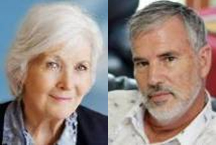
By Aage Myhre, editor-in-chief
aage.myhre@VilNews.com
A new concept for senior apartments, with focus on warmth, dignity and joy. Custom apartments around an outdoor, enclosed patio - plus a large, common 'lobby' for food, reading, music, good talks, therapy, training and more.
Some friends of mine have a large estate just north of Vilnius centre, about 20 minutes drive from the old town and less than five minutes from the Le Meridien Hotel, with its beautiful pool, spa complex, and a great new 18-hole golf course.
The plan they have under consideration right now is to build an elegant senior complex on the site, for potential buyers both in this country and from abroad.
Quality and service will be very high, still at prices one can hardly dream of the United States, Western Europe or Australia.
The planned complex will consist of around 50 apartments and a large public centre-building that can best be compared with an international hotel lobby.
In this 'lobby' one will be met by colorful life as soon as one enters. Dining room, restaurant, cafe, bar, library, piano music, as well as rooms for health, therapy, manicure and sports is that which meets the residents which shall dwell in this totally extraordinary senior complex.
Seniors who buy an apartment here, will in other words not just get a nice place to live, but a total package of food, drinks, activities, care and necessary health care measures in accordance with their own state. Nurses will always be present in the center, and doctors will come here on short notice.
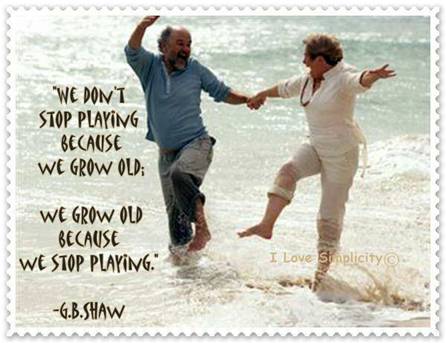
Homes, institutions and facilities for the elderly are too often characterized by the fact that they are not very inspiring and warm. This concept goes in the opposite direction. Here the goal is to develop and build senior housing that helps to improve living, more activity, pleasure, warm and socializing with others.
The plans show a building with two wings perpendicular to each other. Each on two floors, with apartments on both sides of a wide corridor. The current example shows a building with 50 apartments in four sizes, about 45m2, 55m2, 70m2 and 80m2, plus a relatively large 'glass house' in the corner between the two residential wings. The ‘glass souse’ is the meeting point for joint activities, with dining room, café, bar, room for exercise, dance, music, body care, hair salon, a library and a small convenience store.
The outdoor area in the angle between the building wings planned as a green, beautiful atrium bounded by building wings and a garage number which is also built at an angle.
The apartments
All apartments are bright and cozy; with living room, bedroom, kitchen, large bathroom and spacious balconies. It is also done something as unusual as to have two balcony doors (one sliding door, one to open the plain), from the living room as well as from the bedroom, even for the smallest of the apartments. The idea is that fresh Lithuanian air, even on a winter day, and the ability to go out and experience the refreshing wind, rain, snow or sun, is life-giving and inspiring.
Apartments and common areas are all accessible for disabled people, including wheelchairs.
All apartments of assumed equipped with the latest in 'welfare technology' that make life easier and safer for people with various forms of assistance potentially needed from time to time.




Bright
and cozy apartments with living room, bedroom, kitchen, large bathroom and
spacious balconies.
The ’Glass House’
The corner between the residential wings is a prism-like oasis of a glass building that is open up between the floors. To gain an understanding of the impression one would get while coming in here, one should envision a large, bright, attractive lobby of an international hotel. As an open landscape with large green plants, deep chairs, café, newspapers, books, music, happy people in motion, some of the same feeling of exclusivity that you get when you enter a traditional hotel. Ceilings and walls are mainly of glass. The green and welcoming main entrance / porch has been added to the outer corner of the glass house. The inner corner of the ‘Glass House’ opens onto a wonderful green oasis, where a sculpture fountain forms the centre of a symmetrical patio with lots of green garden plants.

The
circular reception is the central point in the 'Glass House'.
KITCHEN AND DINING ROOM
In the ‘Glass House’, closest to the residential wings, are respectively the kitchen and the gym located, both of about 70 m2, with high ceilings (about 4 m) and space for ventilation and engineering controls at the top of the rooms. The kitchen has a separate entrance and door for deliveries from abroad. Vans can drive right up.
Beside the kitchen is the dining room of about 70 m2, with direct access from the kitchen. The dining hall's walls to the lobby area are made flexible with regard to how much they would be opened or closed, so that it can also be made part of the large, open lobby landscape (e.g. for major events). The dining room is furnished with round tables, which will contribute to the dignity of the dining. It is also easier to communicate at a round table. Square dining tables seem slightly canteen-or institution-like with reduced opportunities for communication within small groups.
The food offered will be tempting, modern and of good quality, both nutrition and taste-wise.

The
dining room is planned furnished with round tables, which one believes will
contribute to dignity
and
better opportunities for communication over a tasty meal.


The food
offered will be tempting, modern and of good quality
both
nutrition and taste-wise.
THE BAR
A bar in the classic style with kitchenette, etc., is intended located at the other kitchen wall, towards and as a part of the open lobby landscape.

A good,
classic bar is a natural part of the 'Glass House'.
THE LOBBY CAFE
Opposite the bar, towards the centre of the lobby's landscape, a green and attractive café with French café tables is located. This is probably the most attractive place to sit for a little bit of gossip… Witha glass of wine served from the bar.


The
French lobby café is the place for a cheese board with a good glass of wine
or a
café au lait served from the bar.
THE LOUNGE
The lounge is located on the other side of the 'corridor' in the centre of the lobby. Here are the deep chairs, a good place to sit with a whisky or a glass of cognac to play cards, chess, or to discuss. A black grand piano is for the use of residents who may know how to play, and also fro hired pianists from time to time...
Games, newspapers and silent fonts are in a fit right in 'corridor' between the elevator and reception.


The
black grand piano in the lounge is to the enjoyment of residents who can play,
and for
pianists hired from time to time ...
THE GLASS ELEVATOR
In the 'corridor behind the reception and the newspaper showcase, there is a glass elevator that goes up to the second floor, to a bridge that connects the wings on the second floor. The glass elevator will also indicate that you are in a luxury hotel. Behind the bridge there is also an open staircase up to 2 floor bridge.

A glass
elevator goes up to the second floor, to a bridge that connects
the
second-floor apartment in the two residential wings.
LIBRARY AND TEA CORNER
At the back of the lobby there is a library and tea corner, right next to the glass wall overlooking the atrium, the green grounds in the angle between the wings.
The library and the tea corner is meant for slightly slower pace, with a good book and a cup of afternoon tea while reading. Voice level here is lower, but the view out onto the green outdoors better.

The
library and tea corner is meant for slightly slower pace, with a good book
and a
cup of afternoon tea while reading.
CONVENIENCE STORE
Between the dining room and the main entrance, there will be a convenience store, mainly with glass walls. The store may well have entrance from both the lobby and from outside (external customers). A limited selection of groceries, beer / soft drinks, cigarettes, reading material, etc. should be provided. A 7-Eleven concept.

The tiny
grocery store may well have entrance from both the lobby and from
outside (external customers). A limited selection of groceries, beer / soft
drinks, smoking, reading material, etc. should be provided.
THE ’LOBBY’ WILL BE FLEXIBLE AND MULTI-FUNCTIONAL


The
lobby and the dining room may also well be used for many other activities.
DEPARTMENT OF HEALTH AND BODY CARE
To the right, when you have entered the main entrance, you will find a small room that focuses on health. A general practitioner and other health personnel will be here from time to time to offer simple examinations and consultations. The room also contains equipment and remedies for first aid, etc.
The next room is the division for body care. Here you can cut hair and nails. Hands and feet will be cared for, and in a separate enclosure, you can enjoy body massage and other forms of body therapy. This is also the location of various other therapies, all with a focus on the residents' bodies and wellbeing.

The
hairdresser has an important job to do for both men and women.


Body
care in many different forms contributes to the feeling of well being.
THE FITNESS CENTER
The fitness center, farthest from the entrance, is approximately 70 m2, with a ceiling height of about four meters. Here, various forms of physical activity take place during the day.


Outdoor area - atrium
The outdoor area is one green and relatively closed atrium, limited by the building's two wings and a garage row which is also built as an angle. People from outside cannot see in here. That gives a good sense of security and wellbeing.
The atrium garden is green and symmetrical. In the centre there is a fountain, with water gushing up from a classical sculpture, with a water mirror around. The benches in the circle outside the fountain are ready for leisurely reading newspapers, and more.
The area around the fountain is also suitable as a party space for grilling, outdoor café etc in the summer.
The green square textures surrounded by green hedge-like shrubs year-round with height up to one meter.
Symmetry is the dignity architecture. The sound and sight of water in motion has a good, relaxing effect. Here in the garden one can enjoy and experience the refreshing, life-giving weather almost all year round!



The
atrium centerpiece, around the fountain, is suitable as a party space for
grilling,
outdoor
café etc in the summer.

In the
atrium outer edges, along the main building's exterior walls, one can walk and
feel the
grass
wedge between the toes. The feeling is amazing!
The pavilion and the garages



The
pavilion between the garage wings is suitable for handicrafts, music and more.
In the corner, between the two rows of garages, we see another building with a glass roof, often used as a music pavilion and / or a room for billiards, table tennis, etc. Also various handicrafts can very well take place here in the pavilion. The ends of each wing of the garage are well suited sheds and storages.
The following sketch shows the proposed project for senior housing constructed in accordance with the above ideas and policies.
The project consists of two wings of apartments measuring approx 45m2, 55m2, 70m2 and 80 m2, plus a 'glass house' where dining & wining, activities, etc. will take place.
AREA PLAN

The buildings will be built around a rectangular green and closed atrium, limited by the building's two wings and a garage row which is also built as an angle. People from outside cannot see in here. That gives a good sense of security and wellbeing.
The atrium garden is green and symmetrical. In the centre there is a fountain, with water gushing up from a classical sculpture, with a water mirror around.
- Bookmark :
- Digg
- del.icio.us
- Stumbleupon
- Redit it
- Posted by - (9) Comment
I love Lithuanian girls!
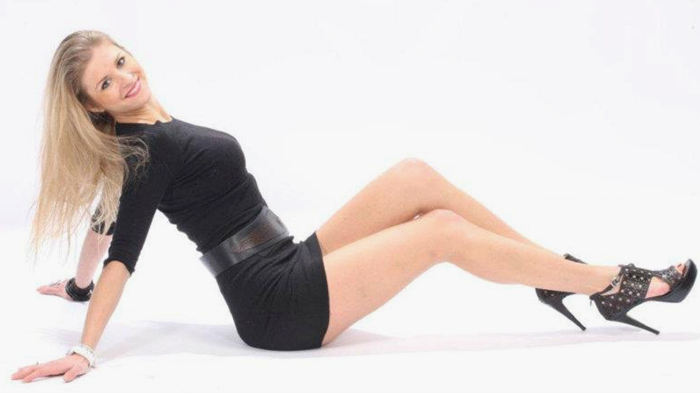
I let Giedrė Jotautaitė represent the thousands of beautiful Lithuanian girls and women
who are not only well-formed by nature, but also do their utmost to keep
their bodies in shape through proper diet, moderate use of alcohol and regular exercise.
Many of these girls know very well how to dress and behave, and
they are fully on a par with their male parallels in terms of intelligence and
ability to cope with challenges at work and on a more general basis.
Lithuanian girls are at the very top in the world, in every way!
By Aage Myhre, editor-in-chief
aage.myhre@VilNews.com
I've been back home in Norway for a few days. I chose to drive this time, and travelled via Riga by ferry to Stockholm in Sweden from where I drove on to Oslo in Norway.
On the ferry ride back to Riga, I discovered quickly that Swedish high school students filled most of the ship. Graduation was to be celebrated and this was done with good help of huge quantities of cheap Baltic booze aboard the ferry, the whole night through.
I have little against young people dancing the night away in a rollicking party when they have something as big to celebrate as a final exam. However, what frightened me was to see that far more than half of the adolescents were overweight and apparently had done little, in the course of growing up, to keep in shape. Swedish girls who in the 1950s, 60's and 70's were world renowned for their stunning, sexy looks, seem now to have been replaced by fattish, inelegant girls who also do not care much about how they dress or behave. The boys are no better.
What a contrast it was to get back to Vilnius, sit down on a sunny sidewalk café and study the endless stream of beautiful, slim Lithuanian girls who walked by. Like sitting in the front row of the catwalk for a perpetual Miss World show...
Lithuanian girls have good reason to be proud of themselves and the nation of Lithuania has very good reason to be proud of its magnificent girls and women...
I sincerely hope that young girls from Lithuania do not go into the same trap as so many sisters in the west have already done. Obesity, alcohol and unhealthy habits have unfortunately become a hallmark for many young people in Europe of today.
The development is anything but merry, but luckily the girls from Lithuania show the way for those who want to return to the beautiful, healthy feminine ideals...
|
Giedrė is a huge fan of VilNews! |
||
|
- Bookmark :
- Digg
- del.icio.us
- Stumbleupon
- Redit it
- Posted by - (0) Comment
Overconsumption of alcohol destroys the lives of more and more young people in Europe
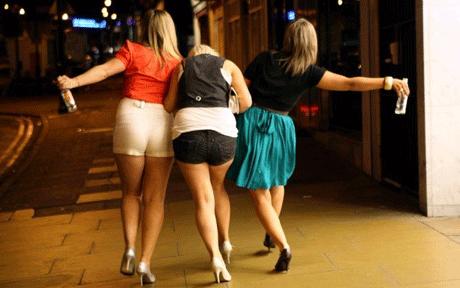
British teenage girls are starting to drink alcohol at the average age of 13,
a new study shows according to The Telegraph. Photo: Christopher Pledger
According to The Telegraph, British researchers have found that today's teenagers start drinking an average of two years younger than women who are now in their mid-twenties did, with most admitting that they had drunk alcohol by the age of 13 or 14.
It is to assume that similar figures apply to many other countries in Europe.
Drinking from a younger age leads teenagers to go on to consume alcohol more heavily, the study also found.
Doctors warn that changes in drinking habits are leading to a rapid rise in the number of young individuals with liver problems.
They say that they are seeing increasing numbers of women in their 20s and 30s with cirrhosis of the liver, a disease virtually unheard of in that age group a decade ago.
A report by a Government watchdog warns that 10 million people in Britain are now drinking at "hazardous" levels.
RELATED ARTICLE
Girls of today are 'stressed, drunk and discriminated against', report finds
Doctors have warned that more people die from alcohol than breast cancer, cervical cancer and MRSA, the hospital superbug, combined.
The study, of 208 women ranging in age from 16 to 24, found that as well as starting to drink at an earlier age, today's teenagers also tended to drink more on typical nights out than women in their twenties.
Overall, three quarters of those asked admitted that they drank more than five units each time they went out, significantly more than the two to three units that women are advised is their daily recommended limit.
In total, six per cent of the women surveyed admitted that they had drunk their entire week's recommended intake in just one night, while one said that she drank 49 units, the equivalent of eight bottles of wine.
The study, carried out by nurses at a sexual health clinic in southern England, also found that the women were more likely to take unnecessary risks after they had been drinking.
One said that she would rather spend her last £5 to buy a kebab and walk home alone, than pay for a taxi.
Others said they had unprotected sex, got into cars with strange men, and even seen their friends fall asleep on roundabouts, after a night spent drinking, the study, carried out by researchers at the University of Manchester and highlighted by Nursing Standard magazine shows.
"Women are commencing drinking at an earlier age and are experiencing the negative consequences of alcohol but show no activity to curb this activity," concluded Valerie McMunn, who carried out the study.
"The negative aspects of their behaviour puts their sexual, physical and psychological health at risk," she added.
Don Shenker, chief executive of Alcohol Concern, said: "This confirms the worrying trend that young girls in the UK are fast catching up with boys in their drinking patterns. We already know that the younger people are when they start drinking, the more likely they are to have problems with alcohol later in life. UK teens drink more than most of their European peers and the growth in consumption is not showing any sign of slowing down. There is a fast growing drinking culture among young people, and girls find themselves under a lot of pressure to emulate a popular image, which includes being drunk or drinking often. Falling prices of alcohol mean that with typical weekly pocket money teenagers can now buy large amounts of alcohol, and many can still get it with ease from supermarkets and off-licenses."
- Bookmark :
- Digg
- del.icio.us
- Stumbleupon
- Redit it
- Posted by - (1) Comment
Amrita Nadi: When researching for the Wisdom of Laughter Album (soon coming), I had delight of "meeting" Teresa Hsu, 112 years old, who inspires with her simple messages of joy. "if you love everybody with all the love in your heart, then you’ll be happy, ha, ha, ha,” Below is a wonderful report on her meeting with an audience in 2010, from the blog of Tsem Tulku Rinpoche
The power of laughter
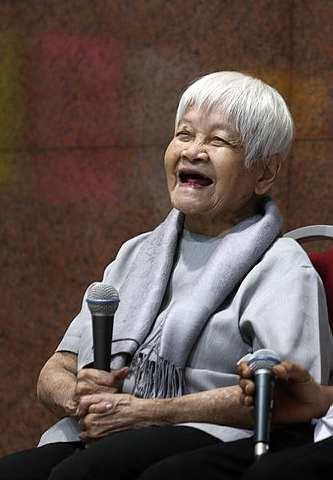
Teresa Hsu
By K. Kaewuni Dewi
CENTENARIAN Teresa Hsu kept some 200 people in stitches during her talk on ‘Love All Serve All’ at the Malaysian Buddhist Association hall in Penang last Friday.
For the bubbly Chinese-born Singaporean, who is affectionately known as Singapore’s Mother Teresa, laughter is definitely the best medicine.
Born in 1898, the 112-year-old social worker extraordinaire keeps young and active by happily doing charity work.
Kicking off the question and answer session Hsu said she was born “very, very poor” and the toughest part of her life was when she had to pick grass to eat as she was “very, very hungry”.
“It was at that moment I thought to myself that no one should ever go through what I went through,” she said.
When asked the secret to her longevity and good health, Hsu responded, “Ha, ha, ha! Make sure your heart is always happy”
She also said eating one raw egg every day for breakfast could be another reason for her good health.
“Once someone told me that raw egg is poisonous to which I replied ‘never mind, I thrive on poison’,” she said....
Having witnessed the suffering of the wounded during World War II, she recognised a calling to serve and at the age of 47, managed to convince the London Nursing College to accept her as a mature student.
She subsequently travelled around Europe to help the sick and needy and was even invited by German Jewish refugees to work in a hospital in Paraguay.
In 1961, Hsu arrived in Singapore to care for her ailing mother and founded the Home for the Aged Sick in Singapore. She has since made the republic her home.
In 2005, Hsu received the Special Recognition Award from the Singapore Government in recognition of her contribution to the country.
Hsu had the audience laughing with her sharp and witty answers to questions. When asked whether she had ever fallen sick, she quipped, “The sick demons forgot to visit me.”
Hsu also imparted words of wisdom to the audience by telling them that when somebody says anything unpleasant, just don’t listen.
“If someone also says they are not happy, go all out to make them happy because if you love everybody with all the love in your heart, then you’ll be happy, ha, ha, ha,” she laughed.
On death, Hsu said she normally does not console the relatives of the deceased but instead makes them laugh.
She told the audience how she got a lady whose uncle had died to laugh and sing along to a Cantonese kindergarten song, and soon had the audience singing, clapping and laughing.
Hsu also said whenever she was faced with a problem, she would try to solve it but if she could not, then she just accepted it.
To another question, she said she wasn’t born naturally caring but shared an incident that deeply affected and changed her. Her late mother once dug up potatoes to feed the family but gave away the entire pot to a starving beggar who arrived at their doorstep with a child.
“That was the day I learnt that to give what you have in your hand to others is a great blessing,” she said.
When asked how important religion was to her, Hsu said, “Nobody ever told me what a religion was”.
She cited an incident when a Buddhist man and a Christian lady were arguing and singing praises about their respective religions.
She told them, “Brother and sister, there’s just one door”.
She added: "Everyone is my brother and sister. My religion is Love."
----------------
© 1995-2010 Star Publications (Malaysia) Bhd (Co No 10894-D)
- Bookmark :
- Digg
- del.icio.us
- Stumbleupon
- Redit it
- Posted by - (2) Comment
“Our ancestors always whisper in our ears, they beg to be understood”
 |
Last week we brought an article with the latest statistics from the World Health Organization, showing that Lithuania again is on top when it comes to suicides – with 61,3 men and 10,4 women per 100,000 inhabitants deciding to end their lives this sad way – annually.
Dainius Puras, a Lithuanian psychiatrist, explains how it is the uncertainty and unpredictability of the economic situation that have such a detrimental effect: "People don't like change,” he says, referring to Lithuania’s 20-year period of dramatic social and economic change since the fall of the Soviet Union in 1991”. |
Response from Vijole Arbas in Kaunas:
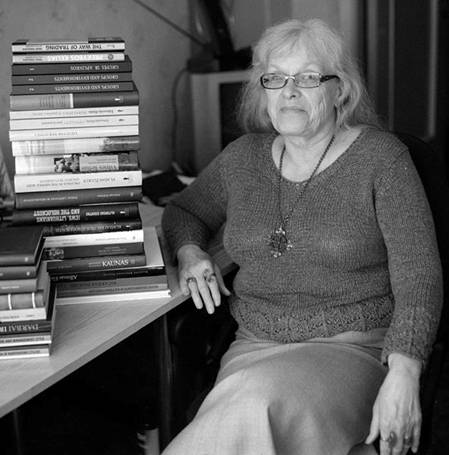
This cannot be the only explanation -- we are plagued by bad spirits of our past, we can't seem to "clean up", to make amends.
Jūratė Sučylaitė wrote a novel (can't recall the exact title Pokalbis su Ragana, somthing like that). Her thesis (if I may call it that) is that our ancestors always whisper in our ears. They beg to be understood. That does not mean to glorify but understand, realize why, forgive, make amends. People want to drown out those voices of the dead by alcoholism, suicide. It is a haunting story that rings very true to me.
On the other hand, the ancestors of American Lithuanians also whisper, also had the sins of betrayal against one's fellow man as well as of victimization. Why don't they hear those ghosts?
A film by V. Landsbergis Jr., When I Was a Partisan, also deals with this sort of concept.
 |
Irene Simanavicius: There is so much more to this...so much more. Those of us that grew up in North America and have visited Lithuania got to know and love people we have met during our visits. People young and old shared some of the stories that were heart wrenching. I agree with Vijole Arbas 100 %. |
- Bookmark :
- Digg
- del.icio.us
- Stumbleupon
- Redit it
- Posted by - (3) Comment
Lithuania has the world’s
highest suicide rate

Latest statistics from the World Health Organization show that Lithuania again is on top when it comes to suicides – with 61,3 men 10,4 women per 100,000 inhabitants deciding to end their lives this sad way – annually.
Dainius Puras, a Lithuanian psychiatrist, explains how it is the uncertainty and unpredictability of the economic situation that have such a detrimental effect: "People don't like change,” he says, referring to Lithuania’s 20-year period of dramatic social and economic change since the fall of the Soviet Union in 1991”.
He describes the reaction to freedom in 1989: "Many people could not manage to cope with this change, with this huge societal stress . . . [they] regressed to destructive or self-destructive behaviour." The stress, he says, prompted an unprecedented crisis of mortality, one that still exists. In Lithuania, with a population of just three million, 5,000 people die every year because of "external causes" - suicide, homicide, violence. He describes it as an epidemic.
Lithuania - a prophetic microcosm of the global crisis?
Puras sees Lithuania's experience as a prophetic microcosm of the global crisis: a society undergoing enormous stress because of the effects of a toxic system, culminating in an “explosion" in the form of a financial crisis. He also points out a strange trend: the more severe the threat to human life, the better societies and individuals seem to fare in their mental health. "History shows that when it is a real crisis like war, or when people are starving, there is a huge decrease in mental health problems, including suicide. During the war you have to survive physically; existential problems are not so important. Suicide is mainly the price we pay for civilisation."
Figures for the UK support his theory - during the First World War, the suicide rate dropped to 8.5 per 100,000. It then leapt to 13.5 in the interwar years, and fell again during the Second World War to 9.2. Immediate, life-threatening crisis, Puras says, creates a sense of purpose: there's not as much time to worry about yourself.
( From an article in “New Statesman”, by Sophie Elmhirst)
Lithuanian Suicide Hotline
Youth Psychological Aid Centre -Vilnius Youth Line
Jaunimo psichologinés paramos centras
Rasu g.20, LT-11351 VILNIUS
Hotline: 8-800 2 8888
Website: jppc.lt
Hours: Mon, Tues, Wed, Thurs, Fri, Sat, Sun: 16:00 - 07:00
SUICIDE IN LITHUANIA
Lithuania Takes the Dubious Honor of Having Highest Suicide Rate in World
An article from year 2000, by LEYLA ALYANAK © Earth Times News Service, VILNIUS, Lithuania
This tiny former Soviet republic on the shores of the Baltic Sea has acquired a dubious distinction: It has the highest suicide rate in the world. Suicides have increased steadily since independence in 1990, especially among young men (up 195 percent) and women aged 50 to 59 (up 106 percent). In 1996 the suicide rate hit an all-time high of 46.4 per 100,000 people before settling at 44 in 1997. These figures compare with 38 per 100,000 in Russia, 34 in Estonia, 33 in Hungary, 20 in Switzerland, seven in Spain, and three in Greece.
According to one specialized report on suicide, more people kill themselves in Lithuania each day (four to five) than die in traffic accidents. But these figures are relatively new and suicide has never been a traditional characteristic here. Before World War II, suicide rates in Lithuania were far below those of many other Eastern European countries. Now, the Baltic States, with Lithuania up front, are leading the pack. "Suicide cannot be explained using only individual reasons," said Dr. Danute Gailiene, a psychologist and specialist in social issues. "It is the consequence of a complex process." That process includes decades of Soviet domination, a dramatic transition period, the amount of media coverage given to suicides, and a certain perceived helplessness toward all of the above. These factors are intensified by the absence of a national suicide prevention strategy and a lack of in-depth research into the problem of suicide. Experts say radical reforms in Lithuanian society have brought about a crisis in values, while growing economic unease has combined with increasing psychological and social insecurity and feelings of helplessness. Still, they cannot pinpoint specific causes. Dr. Gailiene, writing in Lithuania's 1999 Human Development Report, places part of the blame on the mass media.
Between 1991-1994, she said, media coverage of suicides increased 20-fold. Few facts were spared from articles in the newly unmuzzled press, which described successful suicides in searing detail. Conversely, few column inches were devoted to suicide prevention. Little was known about "danger signals" and how to respond to them. In reaction to the brazen media coverage of the early post-independence years, Lithuania has elaborated new guidelines for reporting suicides. This, government officials hope, will help cut back on the copycat effect. The editorial guidelines try to demystify suicide, steering clear of sensationalism and treating the issue like any other news item. Rather than gory details, the government suggests covering the psychological motives behind the act. It also encourages the dissemination of helpful information such as alternatives to suicide and how to seek help.
While there are no reliable figures on the impact of these guidelines, this "ultimate solution" is clearly a reflection of the wider ills Lithuanians face in their transition from Communism. Their lives have been turned upside down yet psychological support is virtually nonexistent, especially in rural areas, where the rate is highest. People with problems are left to fend for themselves. "On the one hand there is a lack of resources, which does not allow for the rapid establishment, development and maintenance of an effective system of psychosocial support. On the other is the inadequate understanding of the importance of the psychological health of the population by politicians," Dr. Gailiene said. Experts say that more information is needed about prevention strategies, with greater emphasis placed on crisis management and rehabilitation.
According to a study on suicides by the Estonian-Swedish Suicidology Institute, socioeconomic disruptions in nearby Estonia are key factors affecting suicides and also cause depression and anxiety. In Lithuania, these factors appear to have an even stronger effect. The country is feeling the brunt of transition policies and its demographic indicators are being affected. In 1970 the number of children exceeded the number of old people by 82 percent; by 1997 the gap had narrowed to 16 percent. In 1990 there were 9.8 marriages per 1,000, but in 1997 that figure had fallen to 5.1. Child illness is up by 26 percent since 1994, and in 1996 health care accounted for only 4.5 percent of GDP. More than a third of households consider themselves poor, and between 1989 and 1996 average real wages dropped by 35 percent. The country's social and economic fabric has been stretched to the limit.
Alcohol policies have also contributed to anxiety, depression and even hopelessness. Under the Soviet system, liberal alcohol laws were tightened by the Gorbachev administration, and consumption fell significantly during the 1980s. Those restrictions are no longer in place and, as a result, drunkenness is again quite common. On sunny days in Lithuania's cities and villages, small groups of unemployed men and women gather on street corners and gulp down low-cost liquor. If and when the liquor runs out, they too might be pushed to consider options, perhaps even final ones. Copyright © 1999 The Earth Times All rights reserved.
LIETUVOS RYTAS
A Gallup International poll showed Lithuanians were the most pessimistic people among 62 nations polled, with 53 percent of the country believing the year 2000 would be worse than the year 1999.
World Health Organization:
Suicides per 100,000 people per year
The following is a list of suicide rates by country according to data from the World Health Organization, in which a country's rank is determined by its total rate deaths officially recorded as suicides in the most recent available year, last updated in 2011.
Male and female suicide rates are out of total male population and total female population, respectively (i.e. total number of male suicides divided by total male population). The total rate of suicides is based on the total number of suicides divided by the total population rather than merely the average of the male and female suicide rates, because the gender ratio in most countries is not 1:1. Year refers to the most recent year that data was available for a particular country.
|
|
||||||||||||||||||||||||||||||||||||||||||||||||||||||||||||||||||||||||||||||||||||||||||||||||||||||||||||||||||||||||||||||||||||||||||||||||||||||||||||||||||||||||||||||||||||||||||||||||||||||||||||||||||||||||||||||||||||||||||||||||||||||||||||||||||||||||||||||||||||||||||||||||||||||||||||||||||||||||||||||||||||||||||||||||||||||||||||||||||||||||||||||||||||||||||||||||||||||||||||||||||||||||||||||||||||||||||||||||||||||||||||||||||||||||||||||||||||||||||||||||||||||||||||||||||||||||||||||||||||||||||||||||||||||||||||||||||||||||||||||||||||||||||||||||||||||||||||||||||||||||||||||||||||||||||||||||||||||||||||||||||||||||||||||
- Bookmark :
- Digg
- del.icio.us
- Stumbleupon
- Redit it
Preventing suicide
- Posted by - (5) Comment
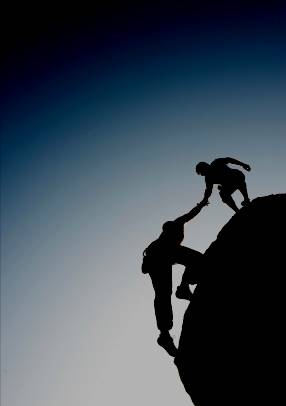
|
An article by the Depression and Bipolar Support Alliance (DBSA) |
If you or someone you know is living with depression or bipolar disorder (also known as manic depression), you understand all too well that the symptoms may include feelings of sadness and hopelessness. These feelings can also include thoughts of self-harm or suicide. Whether we have suicidal thoughts ourselves, or know a severely depressed person who does, there are ways that we can respond with strength and courage.
Understanding Suicidal Thinking
The most important thing to remember about suicidal thoughts is that they are symptoms of a treatable illness associated with fluctuations in the body’s and brain’s chemistry. They are not character flaws or signs of personal weakness, nor are they conditions that will just "go away" on their own. Depression and the depressive phase of bipolar disorder may cause symptoms such as the following:
- intense sadness
- hopelessness
- lethargy
- loss of appetite
- disruption of sleep
- decreased ability to perform usual tasks
- loss of interest in once-pleasurable activities
Taken together, these symptoms may lead someone to consider suicide. However, with proper treatment the majority of people do feel better and regain hope. Recovery is possible.
During severe depression, the systems that regulate emotion become disturbed. People in the middle of a severe depression often think only of things that are dark and sad. Physicians refer to this as “selective memory”—only remembering the "bad times" or the disappointments in life. This type of thinking is a symptom of the illness; it does not define who the person is. And with proper treatment, the individual will start to remember the good times and develop a more positive outlook. (top)
If You Are Feeling Suicidal
If you have begun to think of suicide, it’s important to recognize these thoughts for what they are: expressions of a treatable, medical illness. Don't let embarrassment stand in the way of vital communication with your physician, family or friends. Take immediate action and talk to somebody today. Remember, suicide is a permanent solution to a problem that is temporary.
When people don't understand the facts about suicide and depressive illnesses, they may respond in ways that can cut off communication and worsen their feelings. That's why it’s important to find someone you trust and can talk with honestly and openly. It's also why your mental health professional is an important resource in helping you—and your family. (top)
What You Can Do to Fight Suicidal Thoughts
- Keep a journal to write down your thoughts. Each day, write about your hopes for the future and the people you value in your life. Read what you've written when you need to remind yourself why your own life is important.
- Go out with friends and family. When we are well, we enjoy spending time with friends and family. When we’re depressed, it becomes more difficult, but it is still very important. It may help you feel better to visit, or allow visits from, family and friends who are caring and can understand.
- Avoid drugs and alcohol. Most deaths by suicide result from sudden, uncontrolled impulses. Since drugs and alcohol contribute to such impulses, it’s essential to avoid them. Drugs and alcohol also interfere with the effectiveness of medications prescribed for depression.
- Learn to recognize your earliest warning signs of a suicidal episode. There are often subtle warning signs your body will give you when an episode is developing. As you learn to manage your illness, you’ll learn how to be sensitive to them. They are signals to treat yourself with the utmost care, instead of becoming ashamed or angry with yourself. (top)
Create a “Plan for Life”
Many depression-related suicides occur during someone’s first three depressive episodes—before he or she learns that an episode of suicidal thinking is temporary. As people learn from experience that any given episode will eventually pass, the likelihood that they’ll actually act on suicidal impulses drops sharply. It’s important to have a course of action ready before thoughts of suicide occur. Some people find it helpful to develop a “Plan for Life.” This plan lists warning signs you should watch for, and actions to take, if you feel that you’re slipping into suicidal thoughts. Your “Plan for Life” may include:
- Contact information for your doctor, including back-up phone numbers (emergency services, pager and mobile phone).
- Contact information for friends and family.
- A description of your medical diagnosis (or diagnoses, if more than one)—not just depression but any medical problems you may have. Also include information about any medications you are taking.
- Health insurance information.
- Contact information for a local suicide hotline.
- Contact information for your local DBSA support group.
Click here to view a sample “Plan for Life.”
Educate those you trust about your condition before it becomes a crisis, so that they can be prepared if they’re called on to help. Provide key support people with your “Plan for Life” so they can act quickly, if needed. Carry a copy of your Plan for Life with you at all times so you can refer to it or pass it along to someone else who might be helping you in a time of crisis. With all your important phone numbers in one place, it will be easier for someone to help. (top)
How DBSA Support Groups Can Help
With a grassroots network of more than 1,000 support groups across the country, no one with depression has to feel alone. While DBSA groups do not provide suicide crisis programs, they do provide a caring environment for people to come together and discuss the challenges and successes of living with depression. They don’t offer group therapy, though many groups have a professional advisor (for example, a therapist, a psychiatrist or a psychologist) and all groups have appointed peer facilitators.
DBSA groups provide a forum for mutual understanding and self-discovery, help people stick with their treatment plans and gain support from others who have ”been there.” For information on DBSA support groups in your area, contact us at (800) 826-3632 or see our support group locator.
Facts About Treatment
There are many different medications and therapies available for the successful treatment of depression. Not all medications work the same for all people, so it may take some time for you and your doctor to develop a treatment plan that’s right for you. Stick with it, and recognize that your doctor is your partner in this search. (top)
Recognizing Warning Signs in Others
Sometimes, even health care professionals have difficulty determining how close a person may be to attempting suicide. As a friend or family member, you can't know for certain either. If you sense there is a problem, ask your friend or loved one direct questions and point out behavior patterns that concern you. Remind them that you care about them and are concerned. Talking about suicide with someone will not plant the idea in his or her head. If necessary, suggest that they make appointment to see their doctor and offer to go with them if you sense they would have difficulty doing it on their own. If you believe that immediate self-harm is possible, take them to a doctor or hospital emergency room immediately.
Warning signs may include the following:
- Feelings of despair and hopelessness
Often times, individuals with depression talk with those closest to them about extreme feelings of hopelessness, despair and self-doubt. The more extreme these feelings become, and the more often they’re described as "unbearable," the more likely it is that the idea of suicide may enter the person's mind. - Taking care of personal affairs
When a person is "winding up his or her affairs" and making preparations for the family's welfare after he or she is gone, there is a good chance the individual is considering self-harm or suicide. - Rehearsing suicide
Rehearsing suicide, or seriously discussing specific suicide methods, are also indications of a commitment to follow through. Even if the person's suicidal intention seems to come and go, such preparation makes it that much easier for the individual to give way to a momentary impulse. - Drug or alcohol abuse
Someone with worsening depression may abuse drugs or alcohol. These substances can worsen symptoms of depression or mania, decrease the effectiveness of medication, enhance impulsive behavior and severely cloud judgment. - Beginning to feel better
It might sound strange, but someone dealing with depression may be most likely to attempt suicide just when he or she seems to have passed an episode's low point and be on the way to recovery.
Experts believe there’s an association between early recovery and increased likelihood of suicide. As depression begins to lift, a person's energy and planning capabilities may return before the suicidal thoughts disappear, increasing the chances of an attempt. Studies show that the period six to 12 months after hospitalization is when patients are most likely to consider, or reconsider, suicide. (top)
Responding to an Emergency Situation
If someone is threatening to commit suicide, if someone has let you know they are close to acting on a suicidal impulse or if you strongly believe someone is close to a suicidal act, these steps can help you manage the crisis:
- Take the person seriously. Stay calm, but don't underact.
- Involve other people. Don't try to handle the crisis alone or jeopardize your own health or safety. Call 911 if necessary. Contact the individual's doctor, the police, a crisis intervention team or others who are trained to help.
- Express concern. Give concrete examples of what leads you to believe the person is close to suicide.
- Listen attentively. Maintain eye contact. Use body language such as moving close to the person or holding his or her hand, if appropriate.
- Ask direct questions. Find out if the person has a specific plan for suicide. Determine, if you can, what method of suicide he or she is considering.
- Acknowledge the person's feelings. Be understanding — not judgmental or argumentative. Do not relieve the person of responsibility for his or her actions.
- Offer reassurance. Stress that suicide is a permanent solution to a temporary problem. Remind the person that there is help and things will get better.
- Don't promise confidentiality. You may need to speak to the person's doctor in order to protect the person from himself or herself.
- Make sure guns, old medications and other potentially harmful items are not available.
- If possible, don't leave the person alone until you're sure he or she is in the hands of competent professionals. If you have to leave, make sure another friend or family member can stay with the person until professional help is available.
What You Can Do to Help Someone
Among the many things you can do to help someone who is depressed and may be considering suicide, simply talking and listening are the most important. Do not take on the role of therapist. Often, people just need someone to listen. Although this might be difficult, the following are some approaches that have worked for others:
- Express empathy and concern.
Severe depression is usually accompanied by a self-absorbed, uncommunicative, withdrawn state of mind. When you try to help, you may be met by your loved one’s reluctance to discuss what he or she is feeling. At such times, it’s important to acknowledge the reality of the pain and hopelessness he or she is experiencing. Resist the urge to function as a therapist. This can ultimately create more feelings of rejection for the person, who doesn't want to be "told what to do." Remain a supportive friend and encourage continued treatment. - Talk about suicide.
Talking about suicide does not plant the idea in someone’s head. Your ability to explore the feelings, thoughts and reactions associated with depression can provide valuable perspective and reassurance to your friend or loved one who may be depressed. Not everyone who thinks of suicide attempts it. For many, it's a passing thought that lessens over time. For a significant number of people, however, the hopelessness and exaggerated anxiety brought on by untreated or under-treated depression may create suicidal thoughts that they can’t easily manage on their own. For this reason, take any mention of suicide seriously.
If someone you know is very close to suicide, direct questions about how, when and where he or she intends to commit suicide can provide valuable information that might help prevent the attempt. Don’t promise confidentiality in these circumstances. It’s important for you to share this information with the individual’s doctor. - Describe specific behaviors and events that trouble you.
If you can explain to your loved one the particular ways his or her behavior has changed, this might help to get communication started. Compounding the lack of interest in communication may be guilt or shame for having suicidal thoughts. Try to help him or her overcome feelings of guilt. If there has already been a suicide attempt, guilt over both the attempt and its failure can make the problem worse. It’s important to reassure the individual that there’s nothing shameful about what they are thinking and feeling. Keep stressing that thoughts of hopelessness, guilt and even suicide are all symptoms of a treatable, medical condition. Reinforce the good work they’ve done in keeping with their treatment plan. - Work with professionals.
Never promise confidentiality if you believe someone is very close to suicide. Keep the person’s doctor or therapist informed of any thoughts of suicide. If possible, encourage them to discuss it with their doctor(s) themselves, but be ready to confirm that those discussions have taken place. This may involve making an appointment to visit the doctor together or calling the doctor on your own. Be aware that a doctor will not be able to discuss the person’s condition with you. You should only call to inform the doctor of your concern.
Whenever possible, you should get permission from your loved one to call his or her doctor if you feel there’s a problem. Otherwise, it could be seen as "butting in" and may worsen the symptoms or cause added stress. Of course, if you believe there is a serious risk of immediate self-harm, call his or her doctor. You can work out any feelings of anger the person has towards you later. - Stress that the person's life is important to you and to others.
Many people find it awkward to put into words how another person's life is important for their own well-being. Emphasize in specific terms to your friend or loved one how his or her suicide would devastate you and others. Share personal stories or pictures to help remind your loved one of the important events in life you’ve shared together. - Be prepared for anger.
The individual may express anger and feel betrayed by your attempt to prevent their suicide or help them get treatment. Be strong. Realize that these reactions are caused by the illness and should pass once the person receives proper treatment. - Always be supportive.
People who have thought about, or attempted, suicide will most likely have feelings of guilt and shame. Be supportive and assure them that their actions were caused by an illness that can be treated. Offer your continued support to help them recover. - Take care of yourself.
It’s not uncommon for friends and family members to experience stress or symptoms of depression when trying to help someone who is suicidal. You can only help by encouraging and supporting people through their own treatment. You cannot get better for them. Don’t focus all of your energy on the one person. Ask friends and family to join you in providing support and keep to your normal routine as much as possible. Pay attention to your own feelings and seek help if you need it.
- Bookmark :
- Digg
- del.icio.us
- Stumbleupon
- Redit it
Nida tranquility
- Posted by - (1) Comment

Text and photos: Aage Myhre
aage.myhre@VilNews.com
The quiet resort village Nida is based at the Curonian Spit (Neringa) near the Kaliningrad border, less than one hour’s drive from Klaipeda at Lithuania’s seacoast. With beautiful Baltic Sea beaches on the west side, the large Curonian Lagoon on the east side and the largest sand dunes of Northern Europe on the southern side, this is a truly unique place for a relaxed vacation. You should spend one or two weeks in a self catering fisherman's cottage or a few days in a guest house or hotel. Nida is the place to take it easy!
Here is what a visiting family wrote after their visit:
"We have never visited anywhere that had such a relaxing effect on us as the view from the sun clock on the Great Dune in Nida. The silky-smooth lagoon to one side of the golden spit and the sparkling waves of the Baltic Sea to the other side was breath-takingly beautiful. We did lots of walking, running and cycling including a walk along the Baltic Sea beach from west of Preila back to Nida”.
|
|
|
The Nida home of the German writer Thomas Mann, today the Thomas Mann Museum.
The Curonian Lagoon
|
The Curonian Lagoon is separated from the Baltic Sea by the Curonian Spit. Its surface area is 1,619 square kilometres. The Nemunas River supplies about 90% of its inflows; its watershed consists of 100,450 square kilometres in Lithuania, Belarus, and the Kaliningrad Oblast. At the northern end of the Spit, there is a passage to the Baltic Sea, and the place was chosen by the Teutonic Knights in 1252 to found Memelburg castle and the city of Memel (today’s Klaipeda). The Lagoon, formed about 7,000 years BC, is classified as brackish. Water depths average is 3.8 meters. Nida is very beautifully situated on the west bank of the lagoon. It is from here the fishermen go out on the lagoon in the early morning hours to find the catch of the day. This is where sailing boats gather in late summer evenings. It is in the small streets and on the promenade along the lagoon that the good life in Nida takes place. |
|
|



I
took this picture on a warm late summer evening. I had had a very
enjoyable evening with family and friends, and decided afterwards to go for a
walk along the Curonian Lagoon. The silence, peace, and the slow whisper of the
waves from this large lagoon makes an unforgettable impression. The faint
moonlight and the last sailing boats that were heading towards the Nida harbour
made the impression no less impressive. Nida is a place on earth that
simply MUST be experienced...

The local fishermen are still going strong!





Colourful fishermen homes










A sailors’ paradise





A children’s paradise




The Nida sand dunes are high as mountains
|
Nida is located in the middle of the Curonian Spit (Neringa), half way between Klaipeda and Kalininigrad. The Curonian Spit is a long and narrow sand peninsula that separates the Curonian Lagoon from the Baltic Sea. The huge sand dunes here are the largest in North Europe. A walk on the sand-hills on the outskirts of Nida is an absolute must when you're here. You climb up the steep stairs, take off your shoes. Kilometers of hot desert sand lies ahead. To the east you overview the huge lagoon between the Curonian Spit and the Lithuanian mainland. To the west you can see out over the glassy Baltic Sea almost to Sweden. Fantastic!
|
|



The fantastic Nida beaches – at the Baltic Sea
The Curonian Spit is around 3 km wide here at Nida, and it’s very easy to walk from east to west, over the hilltop, through beautiful pine forests, to some of the finest beaches existing at the Baltic Sea. Probably the best in Northern Europe!
|
|
|

Nida tranquillity awaits you!

- Bookmark :
- Digg
- del.icio.us
- Stumbleupon
- Redit it
Flower power!
- Posted by - (7) Comment
What most people in the West do not know, is that the Lithuanians and other peoples in Eastern Europe are living a double life
Many foreigners think that the majority of townspeople in Lithuania live in dreary grey Soviet blockhouses. They are right, but only to a certain extent. What most people in the West do not know, is that the Lithuanians and other peoples in Eastern Europe are living a double life. For while blockhouse apartments in the urban peripheries are the city dwellers habitat through the winter months, the gardens houses take over as the families’ main homes once the snow is gone. These gardens are in Lithuanian language called a ‘sodas’ and the very garden house a ‘sodo namas’.
Most garden houses are built on land plots just outside the cities. Most were built during the Soviet era, when many city dwellers were given free land by the authorities. This principle is well known in the west, as the so-called allotment gardening principle, but while it has a limited scope in the west, it is in this country and other East European countries very popular and widespread.
Allotment gardens are characterised by a concentration in one place of a few or up to several hundred land parcels that are assigned to individuals or families. In allotment gardens, the parcels are cultivated individually, contrary to other community garden types where the entire area is tended collectively by a group of people. The individual size of a parcel ranges between 500 and 1000 square meters. The individual gardeners are normally organised in an allotment association.
In the 1960s, several new suburbs started developing in Vilnius, and it is today
estimated that more than 70% of the city’s population lives in blockhouses.
Above: View from Antakalnis towards the (by then) new district Žirmūnai.
Photo: Antanas Sutkus, 1964
The 1980s saw the peak of the ‘sodas’ boom with virtually every affluent family in the country having a ‘sodas’ of their own or spending weekends and holidays at friends' ‘sodai’. Often ill-equipped and without indoor plumbing, garden houses were nevertheless the ultimate solution for many working class families to having an inexpensive summer retreat. Having a piece of land also offered an opportunity for city dwellers to indulge themselves in growing their own fruits and vegetables.
The collapse of the Soviet Union saw the return to private land ownership. Most gardens have since been privatized and Lithuania is now one of the world nations with the largest number of owners of second homes. The growth of living standards in recent years allowed many ‘sodas’ owners to spend their discretionary income on improvements. Thus, many recently built ‘sodo namia’ are fully equipped houses suitable for use as permanent residences. The market-oriented economy transformed the ‘sodas’ into an asset, which generally reflects the prosperity of its owner and can be freely traded in the real estate market.
It was in the 1960s that the allotment gardens outside the major cities of Lithuania really took off. My in-laws garden ('sodas' in Lithuanian) is a very good example. Their 'sodas' has over the past 30 years evolved into an incredibly lush, green oasis where family and friends very much enjoy the summer months.
My in-laws were among those who were allocated a land plot outside of Vilnius. Here, they have over the last 30 years developed a truly wonderful oasis of fruit trees, vegetable fields, berry bushes and a fine garden house that has gradually become more and more a house you really can live in the year around.
This is a garden where it really grows during the
summer months - in greenhouses and in the fertile soil.
It is when I come out to my in-laws garden that I really understand that Lithuanians at the bottom of their hearts are genuine farmers who know how to cultivate the rich Lithuanian soil into marvellous harvests.
It is out here I think I'm starting to understand more of the folk soul of this country.
|
|
|
Saslykai - cubes of meat, marinated and prepared over a fire indoor or outdoor
– is always the most popular ‘sodas’ meal.
There are those who say that Lithuanians are cold and unapproachable people. But those who say that have never been on a visit to a 'sodas'. For here is rife not only for flowers, but also people. When you come out here you will experience unique friendliness, neighbourliness, and much good humour. You will smell the food cooking in the fireplace fires or out on the many ‘saslykai’ barbecues. You will hear laughter, and in the evening you will see family after family unite around the dinner tables to enjoy the food that was just prepared on the flames, along with newly picked, fresh vegetables, berries and fruits.

What could be better than enjoying a tasty garden meal with good friends?
My children love their grandparents' garden. Here they can run happily barefoot in God's free nature. Here they can play with their many good friends from last summer. Seen through children's eyes who cannot wait to have the season’s first dive into the river, the Neris River not far away, offers a quiet pool which is very well suited to swimming when the ice has gone and the temperature outside has become blazingly high.
It is not always easy to explain why Lithuania is such an incredibly special place on this Earth. But words are not really necessary if you first get out to a 'sodas' area outside one of the nation's cities. Do not miss the opportunity. Summer is here. Right now…
Aage Myhre
Editor-in-Chief

My kids simply love playing in their grandparents’ garden oasis.
- Bookmark :
- Digg
- del.icio.us
- Stumbleupon
- Redit it
- Posted by - (1) Comment

Breast cancer diagnosis saves lives

The International Women's Association of Vilnius and Roche Lietuva continue the battle against breast cancer
For the third year in a row a charity dinner has been organized to raise awareness and collect money.
All money collected from sponsors and from the dinner will be used to purchase biopsy needles which will then be donated to the main oncology hospitals in Klaipeda, Kaunas and Vilnius.
Breast cancer is one of the most common forms of cancer to affect women. While early diagnosis allows to dramatically increase survival rate, the percentage of breast cancer cases diagnosed at the late three and four stages is still high in Lithuania.
Last year's charity event 'Dancing through the Ages' raised more than 40,000 litas which was used to purchase the biopsy needles which are essential for early diagnosis.
For more information go to http://www.iwavilnius.com/blossom-of-hope.html
For sponsorship contact Barbara Little at barbsvilnius@gmail.com
- Bookmark :
- Digg
- del.icio.us
- Stumbleupon
- Redit it
VilNews e-magazine is published in Vilnius, Lithuania. Editor-in-Chief: Mr. Aage Myhre. Inquires to the editors: editor@VilNews.com.
Code of Ethics: See Section 2 – about VilNews. VilNews is not responsible for content on external links/web pages.
HOW TO ADVERTISE IN VILNEWS.
All content is copyrighted © 2011. UAB ‘VilNews’.

 Click on the buttons to open and read each of VilNews' 18 sub-sections
Click on the buttons to open and read each of VilNews' 18 sub-sections 





















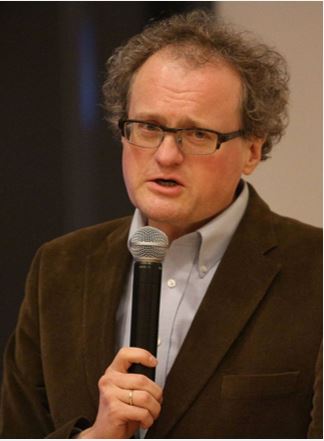
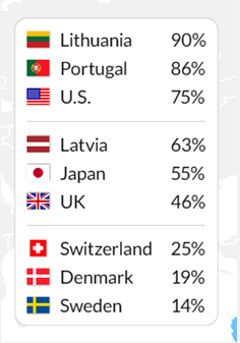
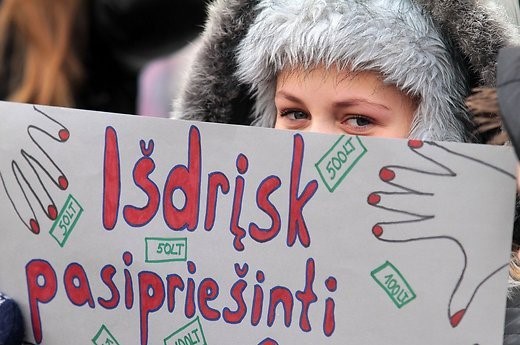


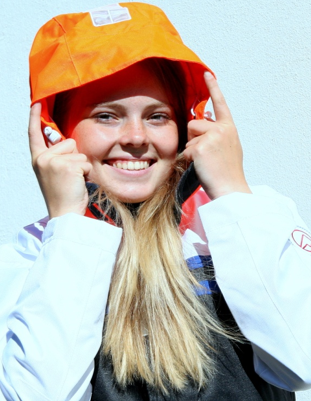
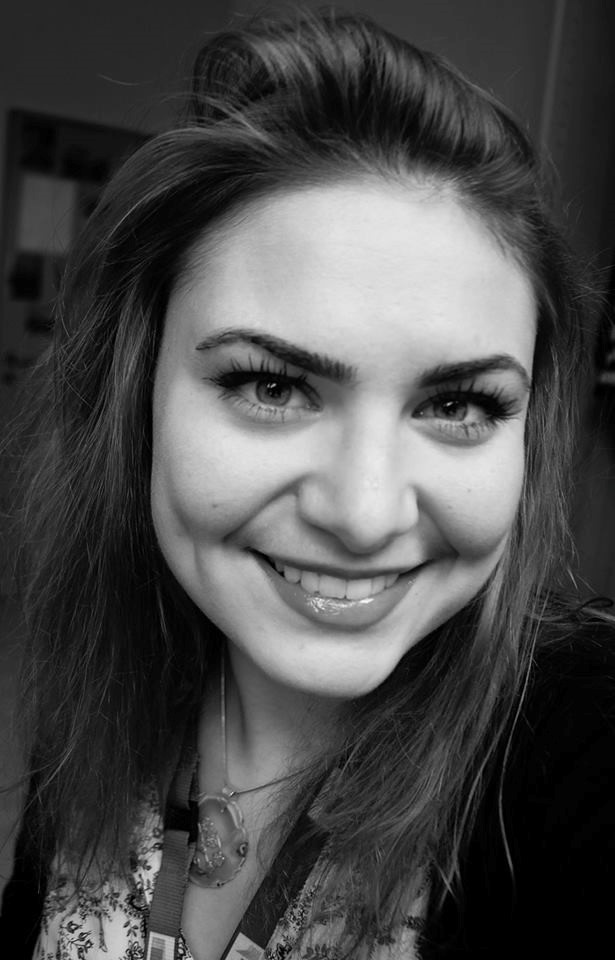
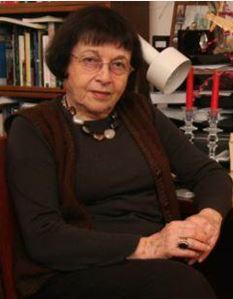

.jpg)
